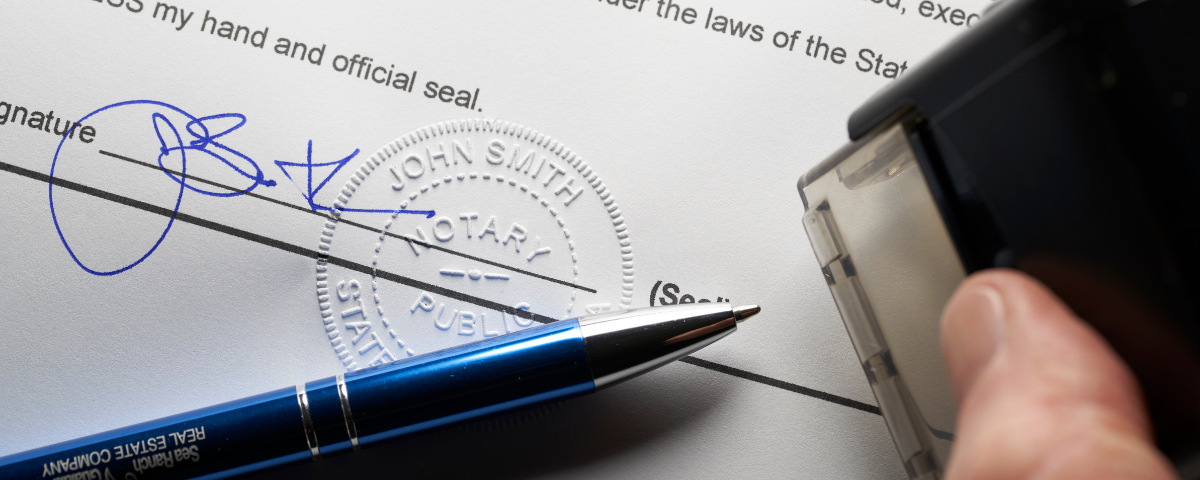So, you’re curious about what states require an embossed notary seal? We get it. As a notary public, you want to make sure you’re following all the rules and regulations, dotting your i’s and crossing your t’s. Let’s face it: nobody wants to end up on the wrong side of the law, especially when it comes to something as important as notarizing documents.
But here’s the thing: the requirements for notary seals can vary from state to state, and it can be a bit of a headache trying to keep track of it all. Some states are totally cool with just a rubber stamp, while others insist on that fancy embossed seal. And then there are the states that want you to have both! It’s enough to make your head spin.
But don’t worry, we’ve got your back. In this article, we’re going to break down exactly what states require an embossed notary seal, so you can notarize with confidence and style. Get ready to impress your clients with your knowledge and your shiny new embossed seal. Let’s do this!
What States Require an Embossed Notary Seal
Notary seal requirements are all over the map – and that’s what makes understanding your state’s specific rules so vital.
Some states are fine with you using a rubber stamp, while others insist on an embossed seal. And trust me, you don’t want to get this wrong – an invalid notarial seal can mean trouble for your notarizations.
Embossed Seal vs. Rubber Stamp
So, what’s the difference between an embossed notary seal and a rubber stamp? An embossed seal physically imprints the paper, creating a raised impression. It’s the kind of official seal you might associate with important legal documents.
A rubber stamp, on the other hand, uses ink to mark the paper with the notary stamp image. It’s quick, easy to use, and required by many states. However, some jurisdictions believe an embossing seal offers an extra layer of security and authenticity.
When an Embossed Seal is Required
In our experience, if a state requires an embossed notary seal, it’s typically for documents like real estate deeds or other instruments that will be officially recorded. The physical imprint is seen as harder to tamper with compared to a rubber stamp impression.
Even in states where an embossed seal is optional, certain agencies or receiving parties may have their own rules mandating its use. It’s always smart to double-check the seal requirements before notarizing a document to ensure compliance with state laws and the specific requirements of the notarial act.
How to Obtain an Embossed Seal
If you’re a newly commissioned notary public, you’ll need to order your official notary seal from an approved vendor. Each state has different specifications for the seal’s size, shape, required wording, and layout.
As a notary public, you’re responsible for the cost of your seal. And remember, your embosser is your responsibility – keep it locked up safe when not in use to prevent any unauthorized notarial acts.
States That Require an Embossed Notary Seal
So, which states actually require an embossed notary seal? As of June 2024, only Colorado and Idaho have this as a firm requirement across the board for all notarizations.
A few other states, like California and Illinois, give notaries public the option to choose between an embossed seal or a rubber notary stamp. So, if you’re a West Coast or Midwest notary, it’s worth confirming your state’s current rules.
We always advise notaries publics to invest in both an embosser and a stamp. That way, you’re prepared no matter what seal requirements a particular document or receiving agency might have.
In some states, you might need to use an embossed seal in addition to a stamp on certain documents, like those destined for the county clerk or other official archives. This raised seal impression adds an extra layer of security, making it harder for others to tamper with the document.
Key Takeaway:
Notary seal rules vary by state. Some states like Colorado and Idaho need an embossed seal, while others allow rubber stamps. Always check your state’s specific requirements to avoid issues with notarizations.
Proper Usage of an Embossed Notary Seal
When it comes to state requirements for an embossed notary seal, following the rules and regulations to the letter is crucial. Mistakes can be costly, but understanding the intricacies can be a game-changer. With over a decade of notary experience, one thing is clear: pitfalls abound, but awareness is the best defense. Getting it right from the start will save time, hassle, and reputation.
Placement of the Embossed Seal
First things first, let’s talk about where to place that embossed seal. Best practice is to put it near your official signature on the document.
You can either slightly overlap the seal with your signature or place it close by. Just make sure the raised impression is clearly visible and not obscuring any important text.
Combining with a Rubber Stamp
Now, in some states that require an embossed notary seal, you might also need to include additional info like your name, commission number, and expiration date. That’s where a rubber stamp comes in handy.
Align your rubber stamp and embossed seal carefully, placing them side by side on the notary certificate. This step ensures you’re meeting all the necessary requirements.
Avoiding Common Mistakes
When using a notary seal, it’s essential to avoid common mistakes by ensuring the impression is dark and easy to read. A clear impression is crucial, and settling for anything less can lead to issues.
Faint, barely-there seals won’t pass muster, especially when embossing on multiple pages, which can result in a too-light impression. To avoid this, aim to use your seal on a single page whenever possible. Additionally, be mindful not to place the seal over signatures or important text, as this can render the document unclear and unreadable.
It’s also crucial to remember to sign the document and use the seal – a step that’s easily overlooked in the rush of the moment. Finally, maintain your embosser in good condition, and promptly replace it if it becomes worn or damaged to prevent any issues with notarizations being deemed invalid.
Maintaining and Replacing Your Embossed Notary Seal
Speaking of maintaining your embossed notary seal, let’s talk about some best practices. After all, your seal is your notarial sidekick, so you want to take good care of it.
Proper Storage
First up, storage. When you’re not using your embosser, keep it locked away somewhere secure. You don’t want any unauthorized folks getting their hands on it.
Remember, you’re responsible for your official notary seal, so treat it like the VIP it is. A locked desk drawer or cabinet should do the trick.
When to Replace Your Seal
Now, even with proper storage and maintenance, embossed seals don’t last forever. So how do you know when it’s time to replace yours?
If your seal is no longer making a clear, legible impression, it’s time to retire it. Same goes for if the plates become misaligned or the embosser gets damaged in any way.
An illegible notary stamp or seal can potentially invalidate your notarization, so don’t take any chances. If you’re unsure, err on the side of caution and get a new one.
You should also replace your seal if any of the information on it is out of date, like after a name change or commission renewal.
Disposing of Old Seals
When it’s time to retire an old embossed seal, proper disposal is essential. Destroying the seal is the best course of action, ensuring it can never be used again. Some effective methods include cutting the embosser in half or smashing the plates.
The goal is to render the notary seal completely unusable. In some states, it may also be necessary to file an official notice with the commissioning agency about the destruction of the old seal.
Key Takeaway:
Use your embossed notary seal near your signature, making sure it’s clear and legible. Combine it with a rubber stamp for additional info when needed. Avoid placing the seal over signatures or text, and maintain your embosser in good condition. Store it securely and replace if worn out or outdated.
FAQs in Relation to What States Require an Embossed Notary Seal
Does a notary seal have to be embossed in Florida?
No, Florida doesn’t require an embossed notary seal. A rubber stamp with black ink suffices for all documents.
Does Texas require a notary seal?
Yes, Texas mandates a rubber stamp type notary seal. Embossed seals are optional but can complement the stamped impression.
Can a notary place a seal anywhere on the document?
Avoid placing it over signatures or text. Notaries should position their seals near their official signature and commission expiration date.
Does a New York notary need a seal?
No, New York doesn’t mandate using any form of physical or electronic notarization stamps or seals for validating documents.
Conclusion
Alright, let’s recap what we’ve learned about what states require an embossed notary seal . We’ve seen that while some states are happy with just a rubber stamp, others demand that extra level of authenticity that only an embossed seal can provide. And a few states even want you to have both, just to keep things interesting.
But here’s the bottom line: as a notary public, it’s your responsibility to know the requirements for your state and to follow them to the letter. Because at the end of the day, your clients are counting on you to make sure their important documents are properly notarized and legally binding.
Show off that embossed seal or proudly wield your trusty rubber stamp – you’re a crucial part of the legal process. Your meticulous attention to detail and commitment to following the rules set you apart. Keep notarizing, friend – you’re crushing it!








 Your Privacy Choices
Your Privacy Choices


